Understanding search intent is a crucial element for achieving SEO success.
Understanding Search Intent or User Intent helps you understand
- Why the user is searching and what he is trying to achieve
- and what type of information offers the best answer.
This article aims to go beyond the “classic” four types of search intent. It will also cover:
- Fragmented intent
- Sub-intents
- And the concept of information gain
You will see that search intent is more than what you think.
Ready? Let’s first start by looking at some examples.
Table of Contents
What is search intent?
Search intent is the user’s goal when he searches for something on a search engine.
For example, does the user want to learn something, purchase something, or go directly to a website?
These options are called types of search intent, and we will cover them in more detail below.
By understanding the search intent, you will:
- Understand why a person is doing a search
- Who is this person
- And what do they expect to find on the SERP
We will see later that the search intent is more nuanced.
First, let’s have a look at concrete examples of a user searching on Google.
Examples of search intents
When someone types “Topic Cluster,” what is his goal?
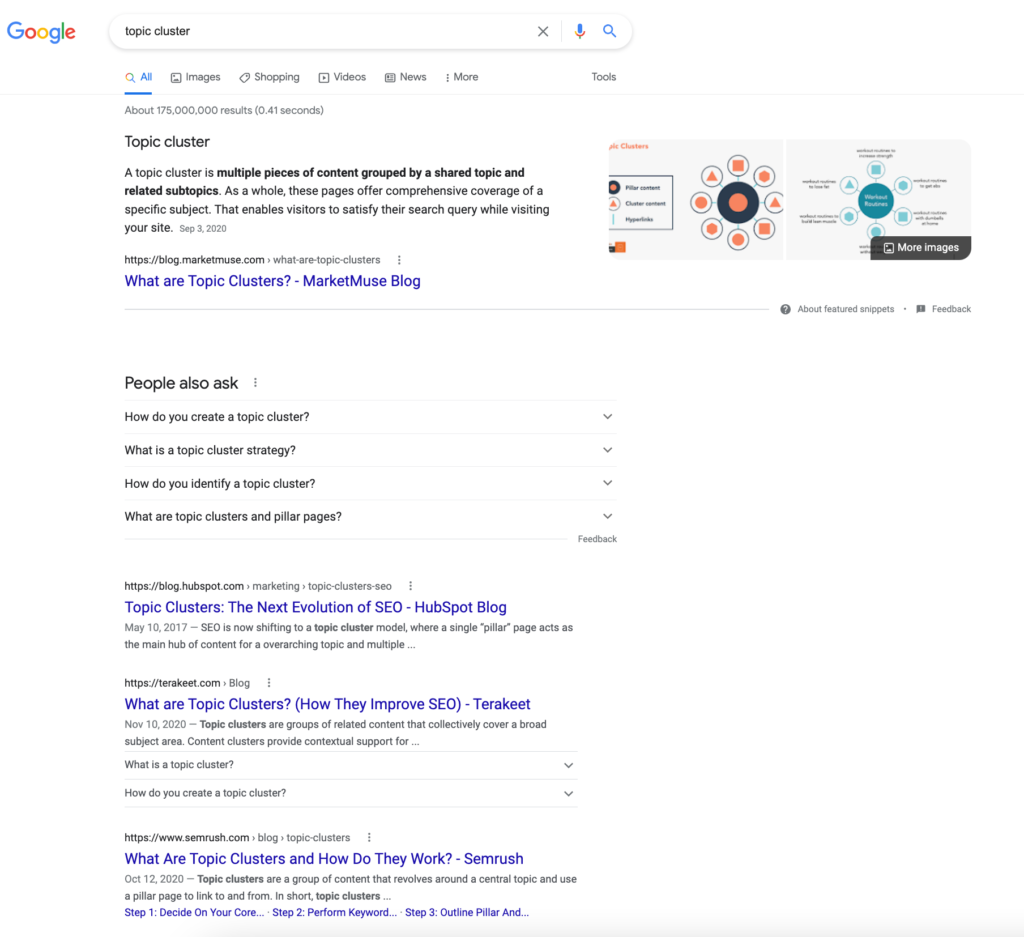
Directly at the top, Google displays
- A Featured Snippet with a definition of the searched term.
- Then there is a People Also Ask box
- and a list of blog posts explaining what a Topic Cluster is.
The goal of a person searching for this term is to learn more about this SEO strategy.
The various elements displayed on the SERP and the blog post’s content indicate an informational intent.
When someone types “thruuu,” what is his goal?
The SERP displays a link to the app or the website as the first result.
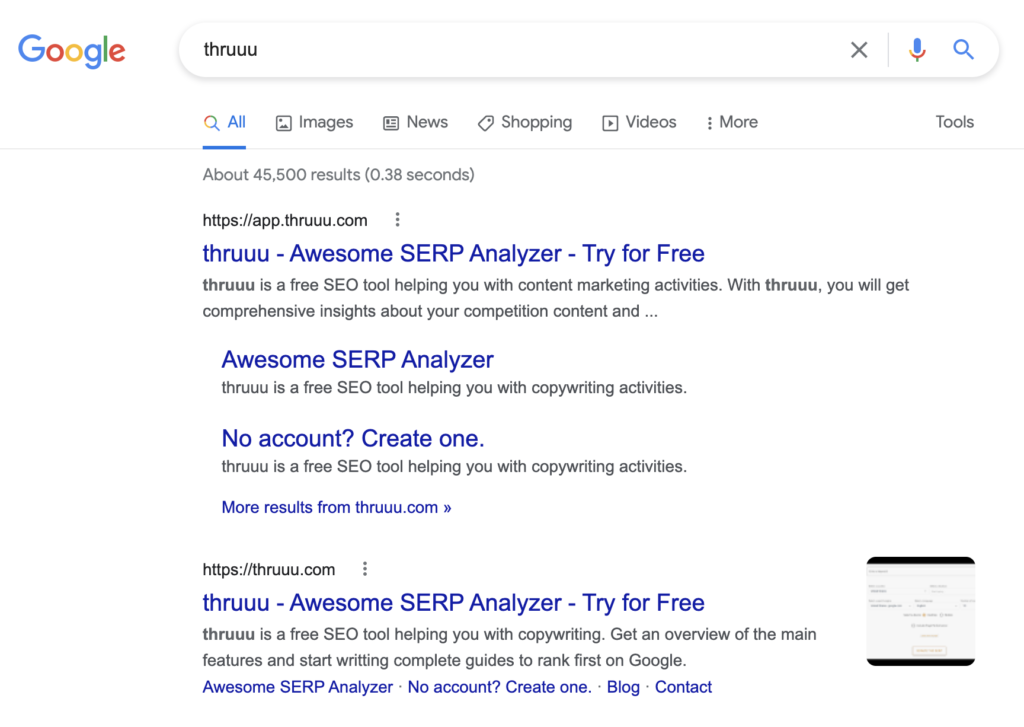
The intent is, without any doubt, navigational. The person wants to visit the thruuu website and its excellent SERP analysis tool.
When someone types “Best CMS,” what is his goal?
The SERP displays a long list of blog posts following a similar format called a listicle.
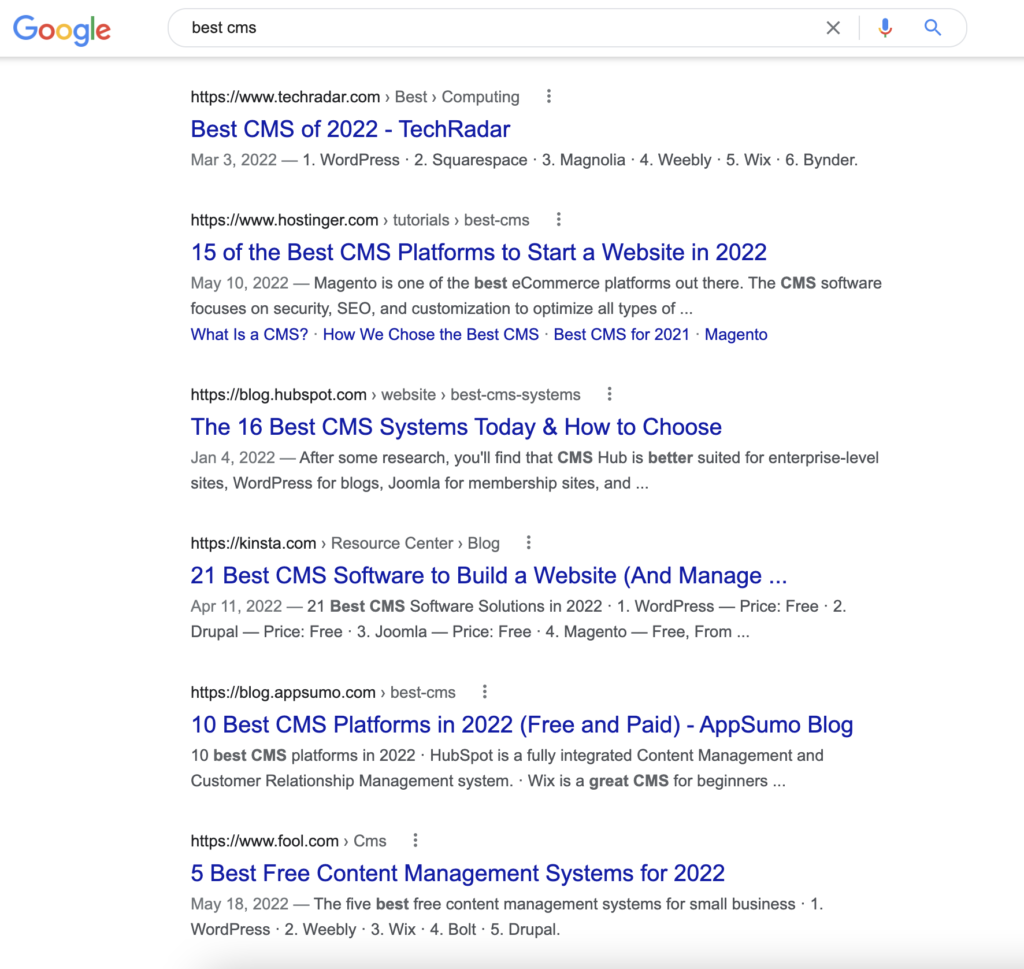
Each article compares the most famous content management systems.
We can assume that someone looking for the best CMS is preparing for a future purchase and needs to evaluate which one is the best for their company.
This would be considered commercial intent. We could also say that the person is in the decision phase if we speak about inbound marketing.
It is hard to say from this query who is behind the search. The related search indicates that there are more “verticals” within this search, and the user could be in eCommerce, a blogger or a developer.
Also, by looking at the results, you will see that some CMS platforms are for enterprises and others for small businesses.
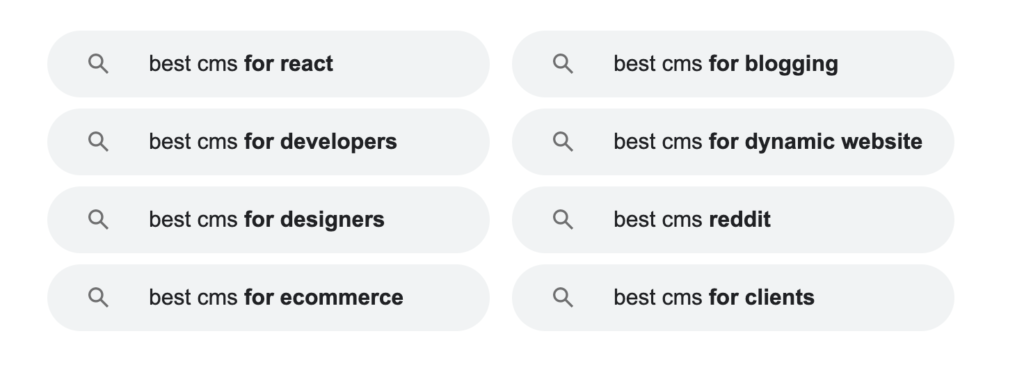
When someone types “Shoes”, what is his goal?
The first thing we can see is the local pack displaying shops in my region.
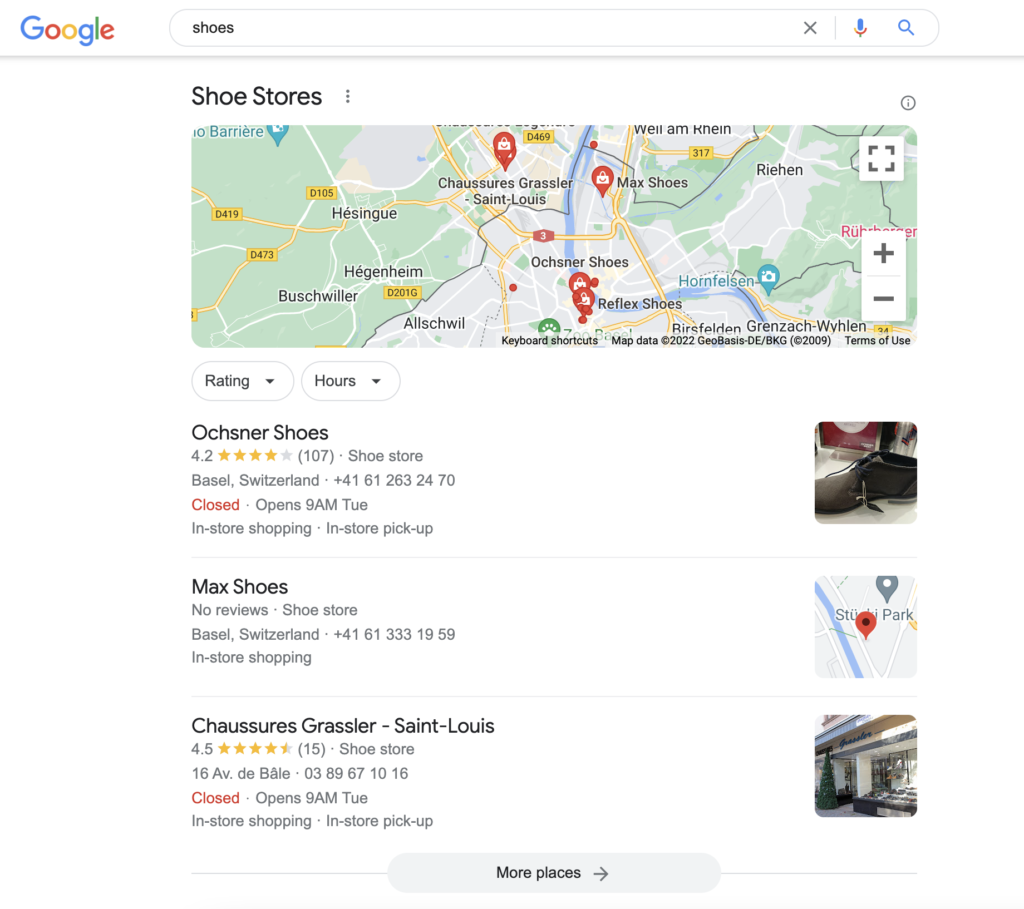
As you can see, I’m at the border between France and Switzerland.
Below the fold, we can see a list of pages, which are mainly e-commerce websites.
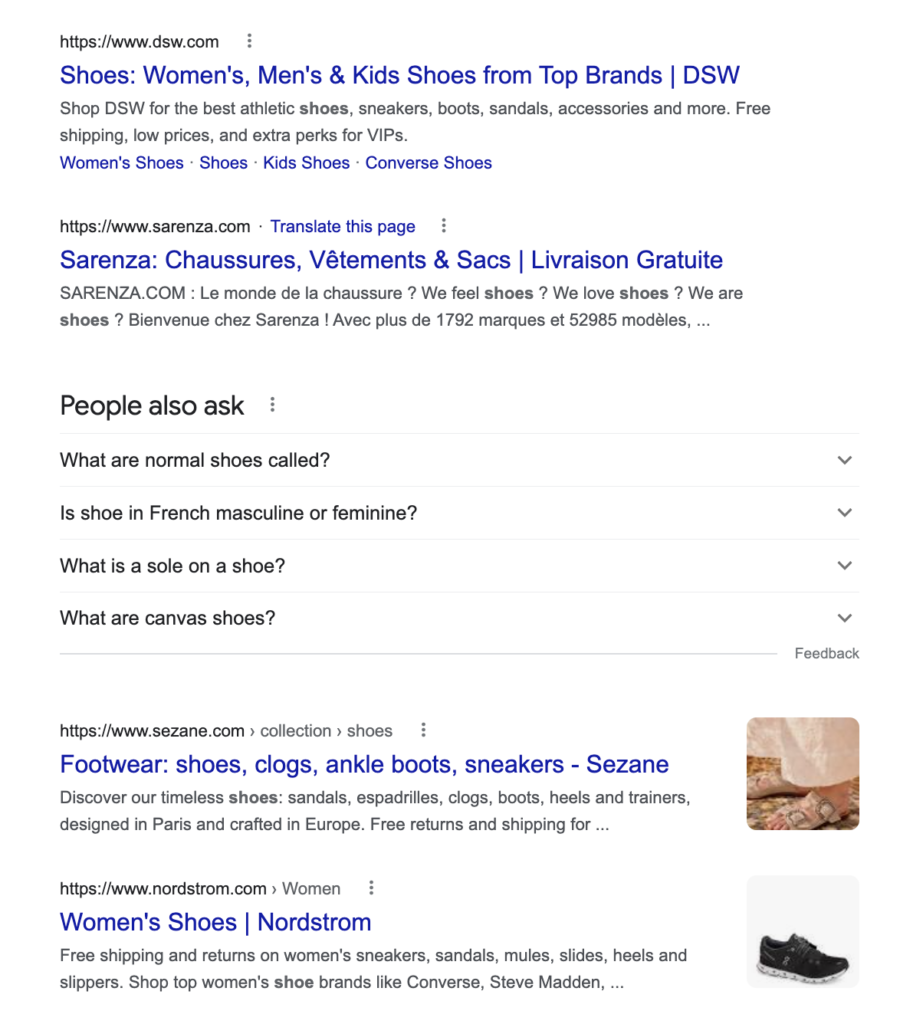
The person looking for shoes is willing to make a purchase either at one of her local shops or online. This is called a transactional search intent.
The titles give us another hint about the dominant audience looking for shoes. You can see that the term women is more prominent.
This is what the SERP is telling us.
In this case, the intent is transactional, even though we could challenge it with the commercial intent.
I told you, search intent is more subtle than this.
With these four examples, you can better understand just how much you can learn about a searcher by analyzing the SERPs.
The 4 types of search intent
As we just saw with the examples, there are four commonly used types of search intent when a user does a search.
Informational
Informational search intent is when someone is looking to learn or discover something new about a topic.
The SERP often lists blog posts or news based on the query. It can also contain SERP Features like People Also Ask or the Answer Box which will show a direct answer to the question.
Queries that are questions often have an informational intent, such as:
- What is SEO?
- How to plant tomatoes?
- Why is the french flag blue, white and red?
Single terms can also indicate an information intent, such as
- Main Coon
- US President
- Account-based management
We will see later that the informational intent is more nuanced, showing more granularity with a deeper look.
Navigational
Navigational search is straightforward. Someone wants to visit a specific website.
The query is often a brand name.
Daily, you might enter navigational queries such as:
- Your bank name
- Your mobile phone provider name
- Your favorite SEO tool
Commercial
Commercial intent is when someone is preparing for a future purchase.
Search queries can contain terms like “best,” “top,” or “review.”
The query can also compare two products, such as “ahref vs. semrush”.
It clearly shows that the person is entering the final stage of his buying journey and is close to a decision.
Also, commercial intent can be represented by long tail keywords or bottom of the funnel keywords such as “mobile app development company in Chicago.”
Transactional
Transactional intent is when someone is ready to buy. One of the keywords that typically shows this intent is “buy”. You could also have the term “deal” or “discount”.
However, even though you can figure out the intent based on the keyword, an analysis of the SERP gives you a better understanding of the intent and what answer is the most appropriate.
Now that we have covered the four types of search intent, I would like to share another perspective:
What does Google mean by search intent?
Also, we will see that there are multiple intentions behind a search in most cases.
You have the basics, now let’s take a deeper dive.
How Google views search intent
Google has its own view on search intent, but it shows similarities with the previously introduced types.
The Google Quality Rater Guidelines is a manual providing instruction to quality raters on how to evaluate the quality of websites.
In this guide, Google also speaks about search intent or user intent in the context of mobile devices and the following terms:
- Know: The user wants to find information about a topic. The information can be broad and complex.
- Know simple: A type of know query where the answer is concise and can be displayed in a small amount of space. This could be SERP Features like Answer Box or Featured Snippet.
- Do: The user wants to do something on his phone, such as download an app, take an online quiz or purchase a DVD.
- Website: The user wants to visit a specific website.
- Visit in person: The user wants to visit a nearby place.
Keep in mind that Google provides this guidance to a pool of raters. Google needs to judge the relevance of the results on the search and determine if they are aligned with the supposed intent.
Google aims to improve the user experience by displaying the right results for a specific intent. Because of this, it has a slightly different perspective of user intent as it is associated with the “Search”.
Google defines the user intent to shape the SERP results.
We, as content producers, have to see the user intent to shape our content.
This explains why there are nuances in the definitions of the search intent types. There is the Google version and what we call the “classic” versions.
In the same guide, Google highlights another element to consider if you want to perform with your SEO: Queries with Multiple Meanings.
Dominant intent and fragmented SERP
Dominant intent and fragmented SERP are other concepts to understand if you want to nail the SEO game.
These mean there might be several intents behind a search.
Same keyword, different intents
In other words, for the same keywords entered in Google, the users might have different ideas in mind and expect a specific result.
Let’s do a test.
What do you have in mind when I say “Apple”?
Most of you will think directly about the company. A minority will think about the fruit and very few about the first name or the city in Oklahoma.
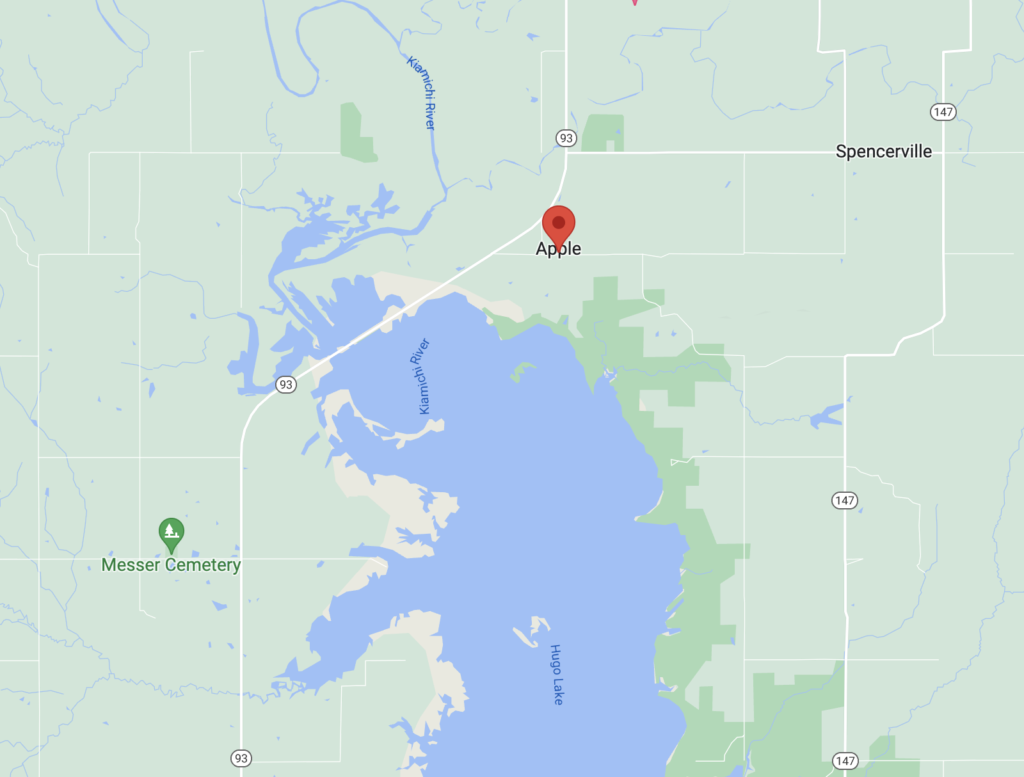
I took this example from the Google Rater Guide. It is a simple example but effective to illustrate that there are various interpretations of the same keyword.
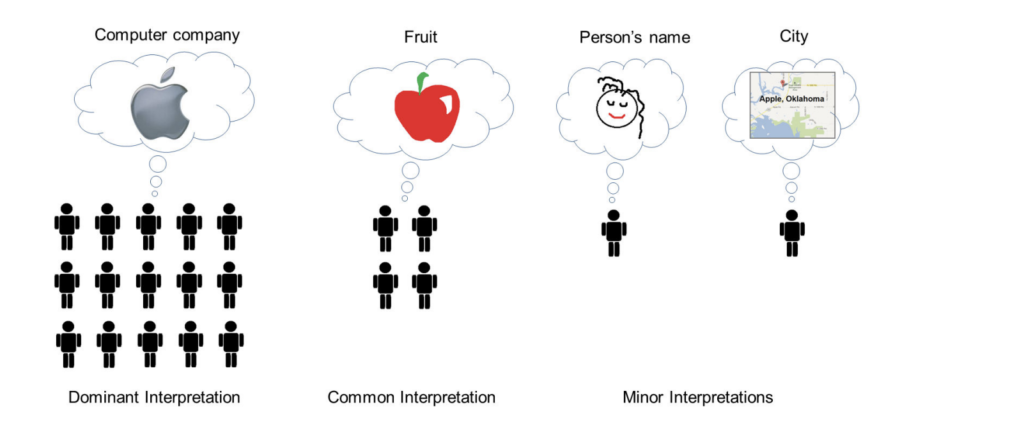
So for (almost) every search, there will be a dominant interpretation and one or several common or minor interpretations.
I’ll let you guess, but Google will display more or less results per interpretation on the search.
And in the case of “Apple”, you have to go to page 2 to find the first mention of the fruit.
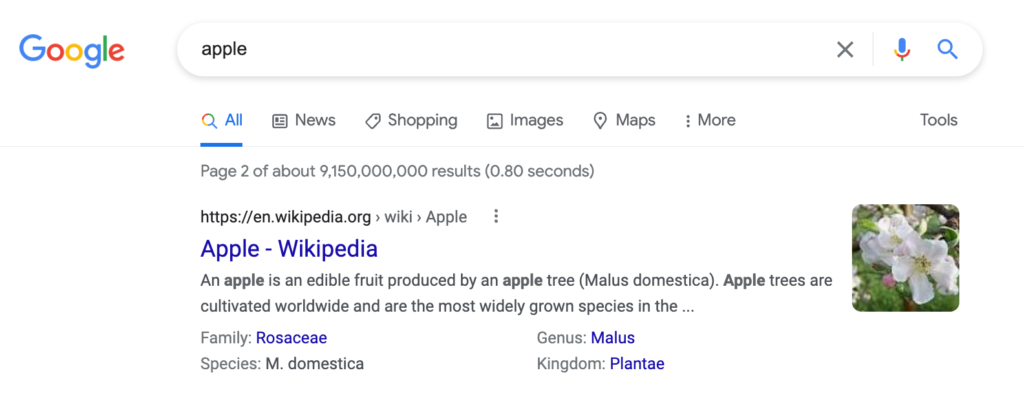
Different intents behind a search lead to so-called fragmented or mixed SERPs.
The following example is even more evident.
What do you expect to see, or what is the intent behind the term kayak?
Here is what Google is showing us.
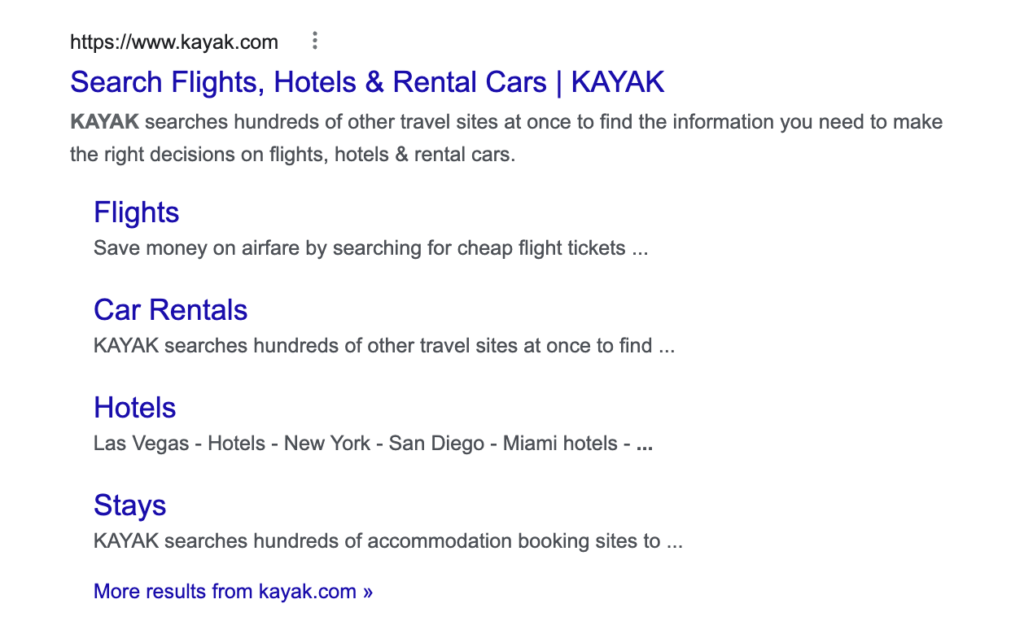
The first block is about the Kayak company. Here it is a navigational or commercial intent. The user wants to go to the Kayak website and book travel.
Then there are Top Stories. At the time of this search, the World Championship of Kayak took place. Someone might be interested in some fresh news.
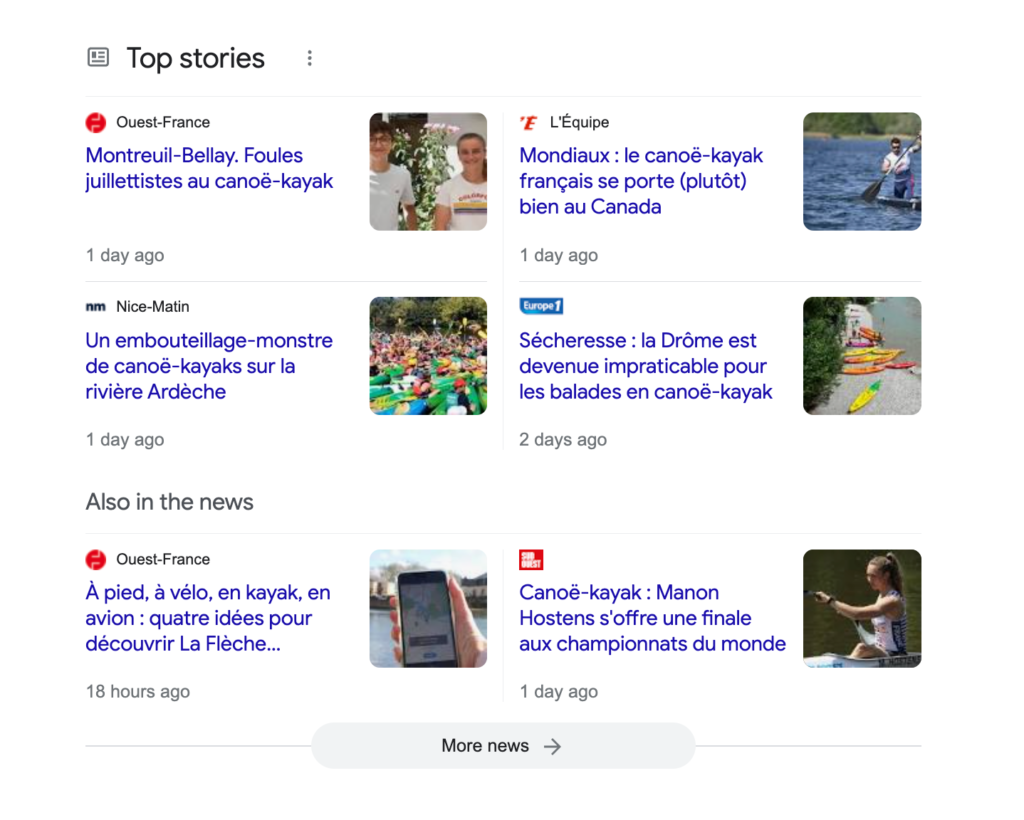
There is also a tiny spot in the middle of the SERP for Wikipedia. If someone is looking for information about a kayak, he can use this result.

Finally, the SERP ends with two eCommerce websites selling kayaks. These results indicate a transactional intent.
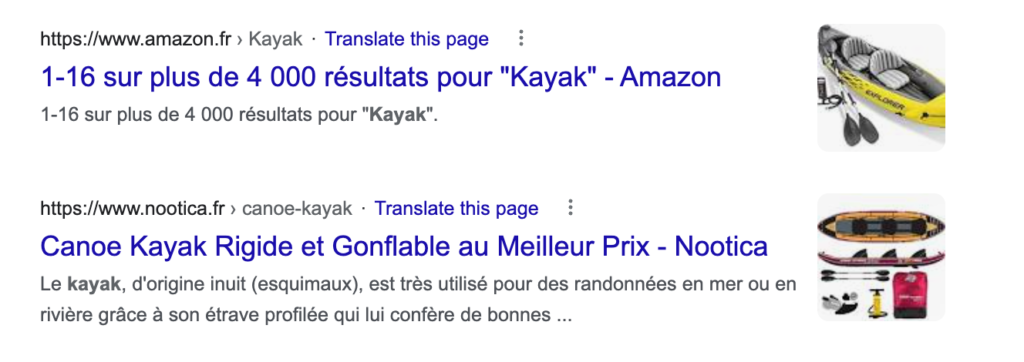
As you can see, the SERP is fragmented, with different results answering different purposes.
This is an extreme example, but it is important that you understand this possibility. This is why keyword research is so important.
Understanding that trying to optimize for the term “kayak” may not achieve your goals due to the fragmented results can save you time and money.
Instead, use your keyword research tool to find long-tail keywords around “kayak” that have a more unified SERP result.
If you are in SEO, you might spend most of your time creating content for informational queries to lead visitors through the customer journey.
But even informational searches can sometimes be fragmented.
The What and the How: Fragmented informational intent
Do you remember the first example I shared?
What is the goal of a person typing “Topic Cluster”.
This person is looking for information.
But what kind of information?
Here we can see several interpretations (or expectations) of the same topic.
This is what the SERP includes for the term “Topic Cluster”.
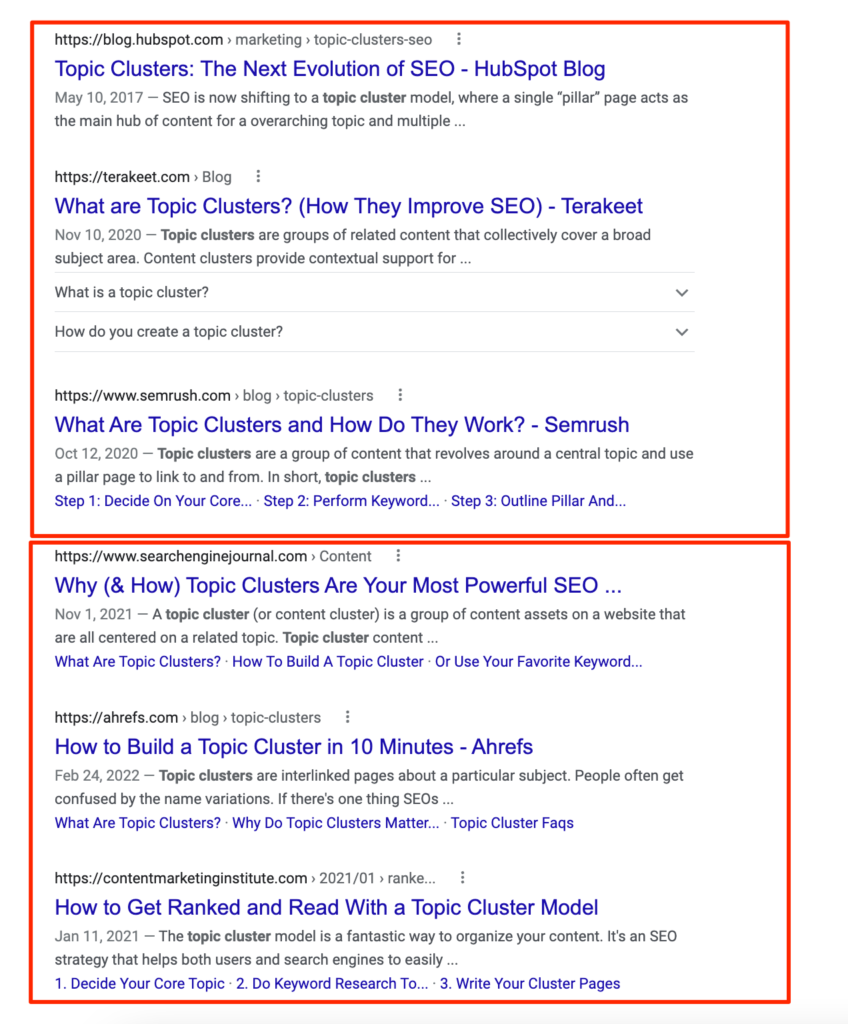
At the top of the SERP, there are articles about “What is a topic cluster”. And further down the results page are articles about “How to create a topic cluster”.
These are two dominant and unique blocks of articles.
What I am trying to highlight is that even if it’s an informational intent, there may be two ways of approaching the topic.
These can include the What and the How.
You must analyze the SERP and each article’s angle to identify similar patterns for your target keywords. It might not just be “what” and ”how”; maybe it is ”can” or ”will.”
The interesting point is that it could guide your content strategy.
Most people might think that to rank for the term “topic cluster”, an article covering the what and the how within a single content would be needed.
I experimented with this theory.
I created two articles about the term “topic cluster” on my blog: one focused on what a topic cluster is and the other on how to create a topic cluster.
Google rewarded me by displaying my two articles on page one.
This was possible thanks to the indent feature displaying related content from the same website.
Google thinks its user might be interested in both content for this search query.
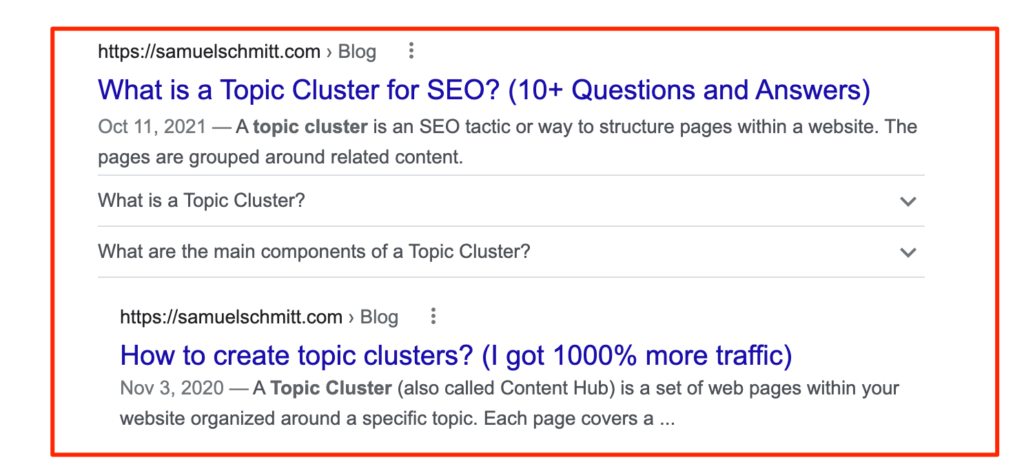
My decision to keep the topics separately was based on the in-depth review I did of the SERPs which showed them as unique articles.
How to analyze and understand the search intent
There are several ways to define the search intent as noted above.
Keywords can hint at what the user intent is, but the SERP can help us further refine the kind of results searchers are looking for.
Keyword intent
Even though I think it is pretty limited, you can still guess the search intent from some keywords.
But it is limited as only a few keywords contain intent-specific words.
For instance, if a search contains “buy” or “deal” or “discount”, we can expect a transactional intent. These types of searches will typically result in a searcher landing on product pages to make a purchase.
Searching products with “vs” between them tends to lead to commercial intent.
But I prefer the following approach to infer the search intent.
Infer search intent from the SERP
Through the SERP, you can see the search intent.
I repeat.
Through the SERP, you can see the search intent.
Google search shows you the best results for a search, and therefore you can understand the goal of a person searching by looking at the SERP.
The SERP Features are a good indicator of the intent.
A direct answer in the Answer box or the People Also Ask at the top indicates an informational intent.
The presence of eCommerce or product listing shows a transactional intent.
The table below can give hints about the search intent based on the features displayed on the SERP.
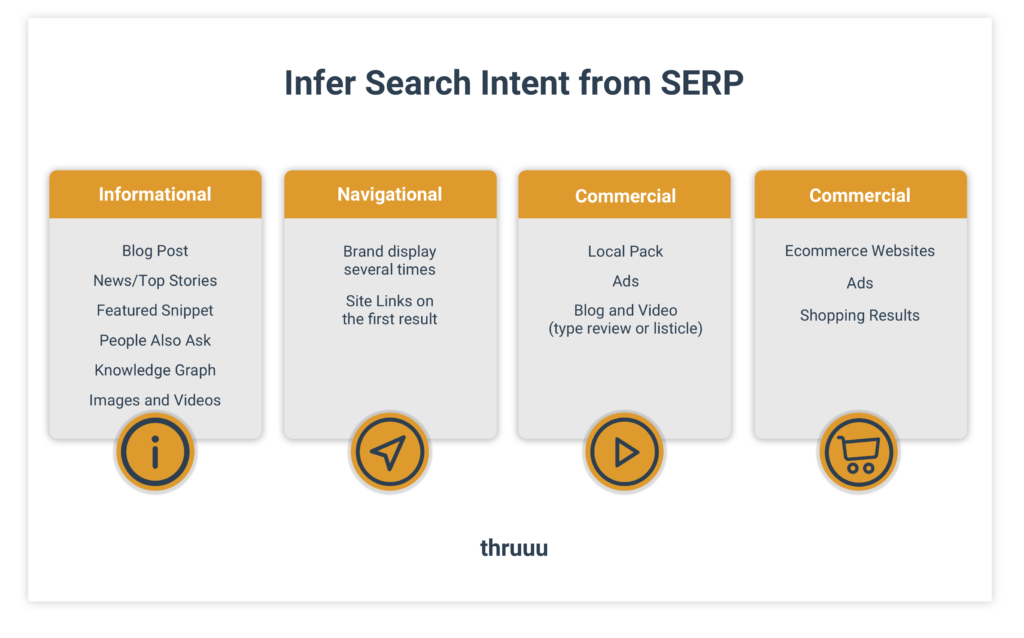
How to optimize your content for search intent (with examples)
Now that the search intent is better understood. Let’s put it into practice.
We will continue with an example of an article I created for my blog about tools to test the Core Web Vitals. (Don’t worry if it sounds too technical, you will get the point).
1 – Analyze the SERP
My target keyword is “core web vital test” or “test core web vital”, they are basically the same.
My first move is to do a search on Google and check the SERP results.
I immediately find two search intents or two interpretations of this search.
Some searchers are looking for a tool to test their Core Web Vitals, and the SERP lists three different tools for this purpose.
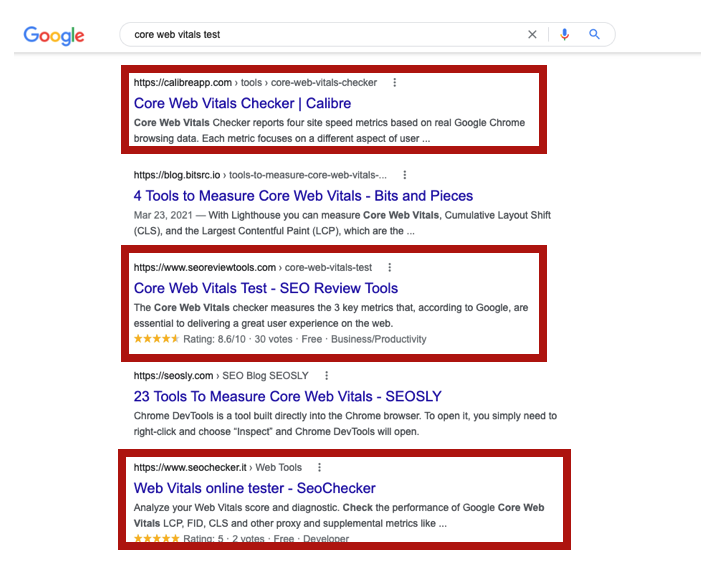
The other group of searchers is looking for a list of tools to test the Core Web Vitals. They need some options to decide which one is the best.
This is represented by listicle blog posts.
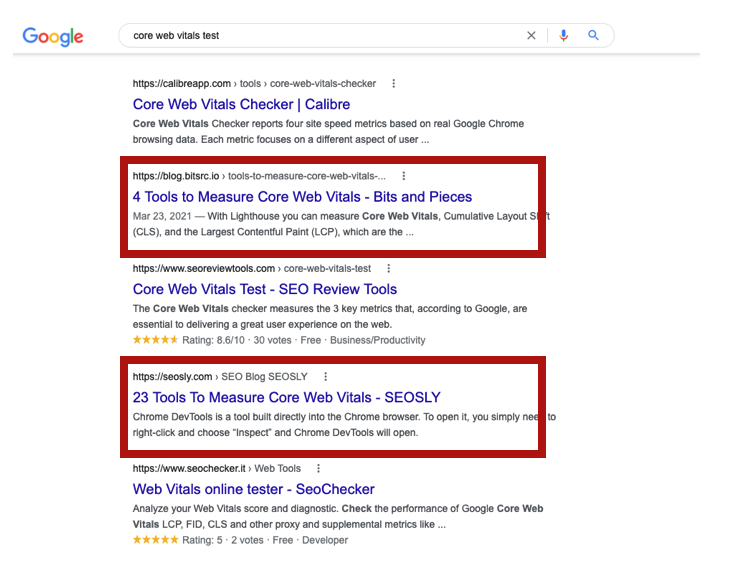
I didn’t show you the top of the SERP where Google websites are listed (Indeed, the Core Web Vitals is a Google metric, and I don’t think I will overtake their spot).
I aim to create an article, so the SERP shows me already few things:
- The type of content must be a listicle
- The space on page 1 is limited for another blog post. Only 2-3 are displayed.
But you know I don’t fear any challenge, and I will try to push my content on this SERP.
2 – Structure your content
Looking at the SERPs gives me essential information about the content I need to write.
I can see my post needs to be a listicle based on the ranking pages.
By deep diving into the SERP with thruuu, I get a good idea of the structure of my content in a couple of minutes.
By looking at the competitor’s outlines, most frequent keywords, and questions used in their content, I know the tools I need to list.
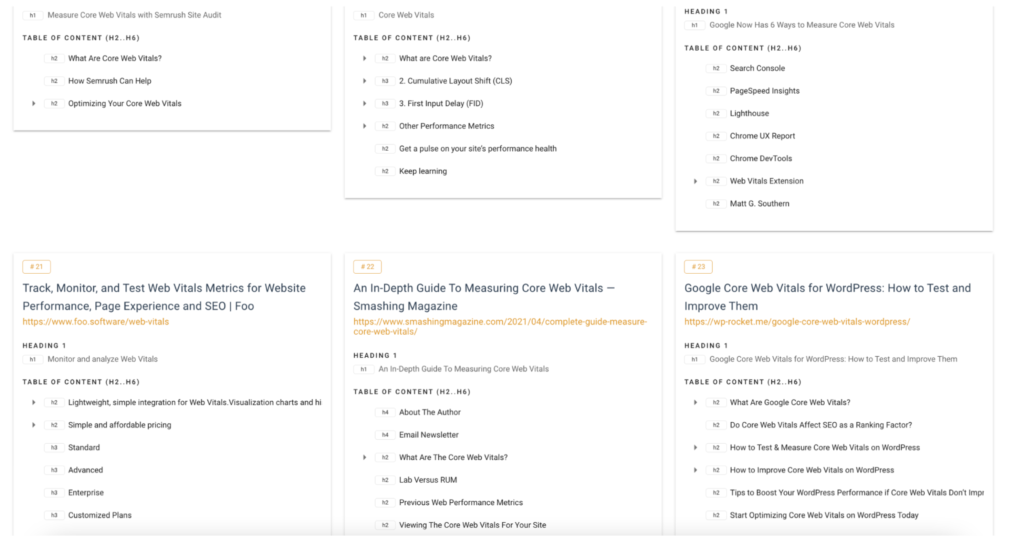
3 – Information gain: Don’t copy. Offer a new angle.
Now that I have a complete list of tools and the most important questions to answer, I can create my content outline.
But I took a step back and looked back at the SERP.
I was wondering if it would make sense to make another list of tools as there is already one that seems complete.

What should I do?
Make the 25 tools to measure the Core Web Vitals.
Why will Google promote my content when there is already something in place? Something excellent and complete.
So here comes the so-called concept of “Information Gain”.
It is a new fancy term in SEO.
My definition of information gain or my approach is to bring something new to the table or deliver the content from a different angle.
My approach here was still to make a list of tools, but I will list only the free ones.
Focusing on free tools is my angle; hopefully, this differentiator will help me get a spot on the SERP.
As you can see, I don’t care about the number of tools, as 13 does not beat a list of 23. But maybe FREE wins over a more generic listing.

4 – Fine tuning my content brief
Creating a content brief is a critical step in the SEO content process. It will speed up your content production and ease the collaboration with your team of writers.
The thruuu content brief generator has been designed to have SERP analysis at its core.
With a few clicks, I can fine-tune my content by scanning my competitors and understanding the main topics to use.
My final brief looks like this: There will be a big chunk about the Google tool to test the Core Web Vital and a list of free third-party tools.
As you can see, thruuu is in the list as it also helps you analyze the performance metrics of the SERP, and you can get started for free.
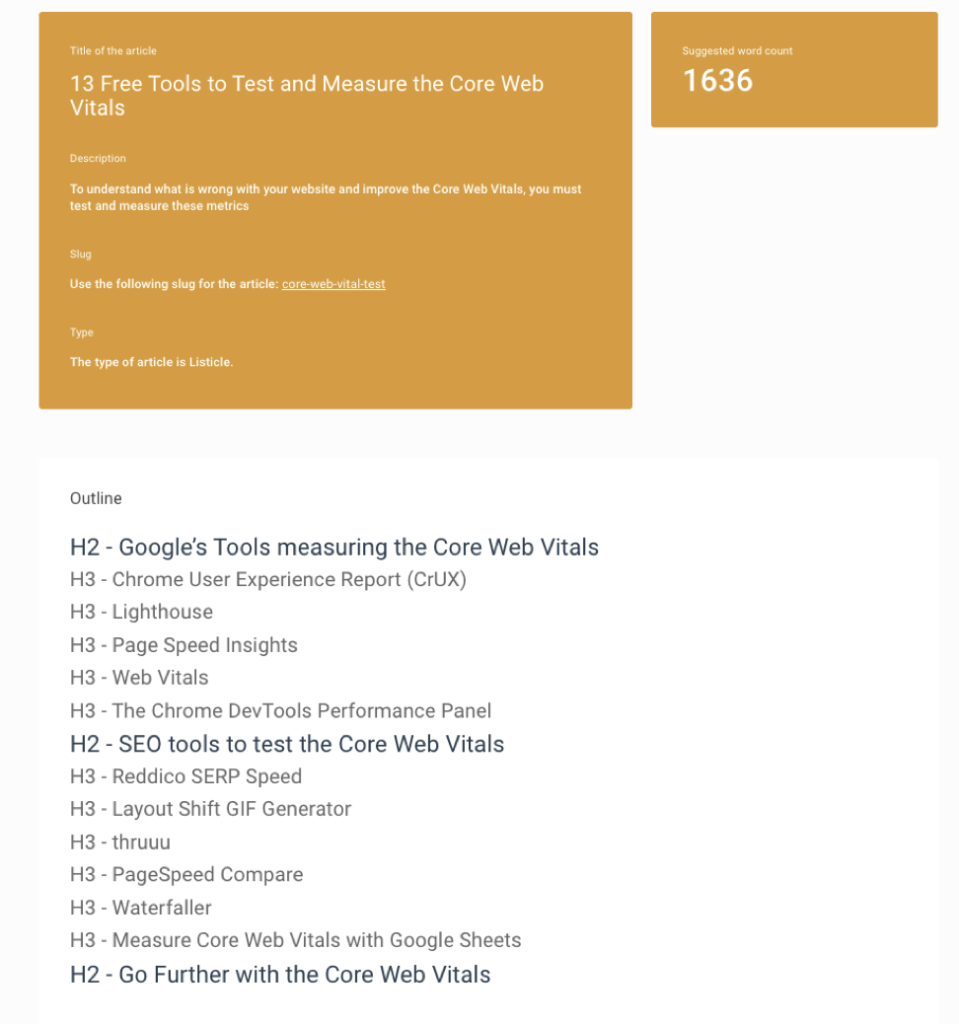
Now that my brief is very well structured. I can finalize my article and publish it.
Final results
I published the article in February 2022, and now (August 2023), the article ranks on the first page of Google.
And as you can see, it beat the other blog posts.
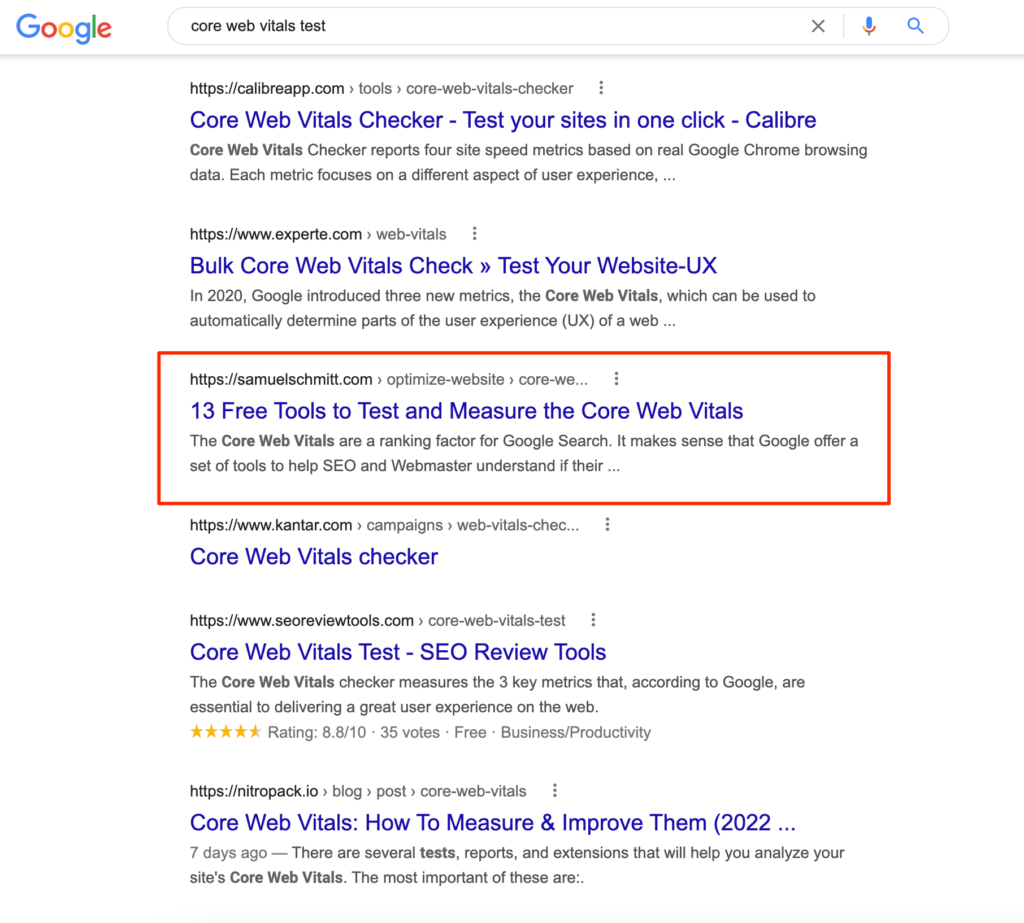
The “I’m looking for free tools” intent was more dominant.
What is also interesting is that it is not the longest one in terms of word count. The other blog posts have 3000+ words, while my article has a little 1200+ words.
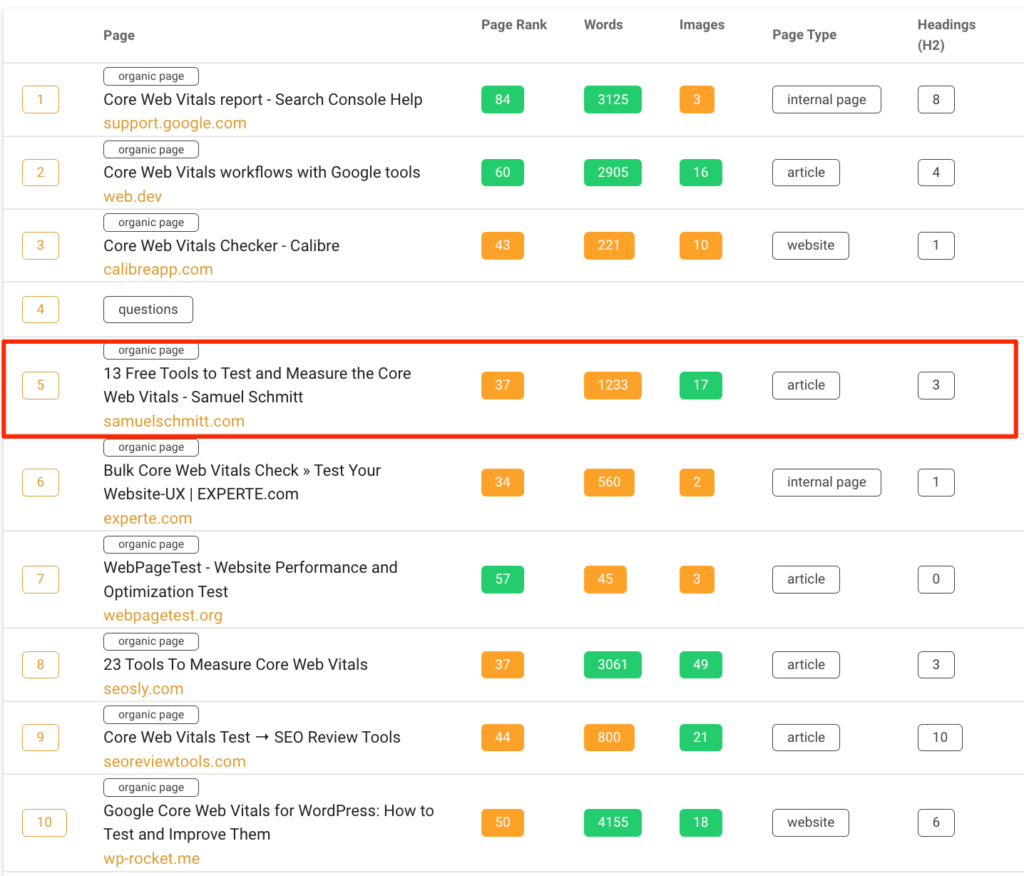
What matters is to nail the search intent and come with good content.
Why is search intent important in SEO?
If you are not yet analyzing the search engine results to understand search intent, I beg you to start now.
It is essential and can help you:
Speak correctly
Understanding what people are looking for will help you find the right way to speak about a topic—identifying how to create content searchers want is critical to SEO success.
Understanding search intent is crucial to rank well for a specific search term, increase click-through rates, and grow organic traffic.
Structure your copy
People expect results to be in a specific format and contain in-depth information.
By understanding the search intent, you will have a better content structure.
Increase organic rank
SEO is getting increasingly competitive, and user expectations are getting higher.
You must develop unique content that is better than your competitor’s pages.
Without excellent content that is well-optimized, your chances of ranking well will be limited.
What SEO tools can help you analyze the search intent
The best SEO tools to analyze search intent are tools that extract data from the SERP and offer detailed reports.
With thruuu, you get access to a lot of data from the SERP and your competitors. Our solution helps you to:
- Analyze any Google SERP
- Extract the number of words, image,s and page rank
- Understand the type of content ranking on Google, the outline structure of your competitors, and the topics they cover .
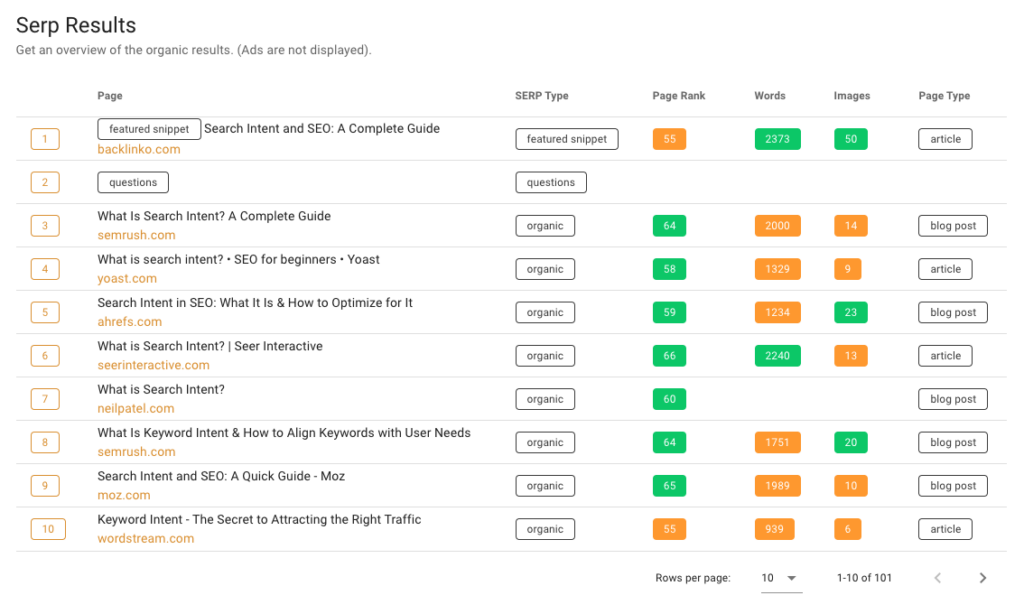
You can easily explore the frequent information discussed by the top-ranking pages. This helps you structure your article to align with the user’s expected answer.
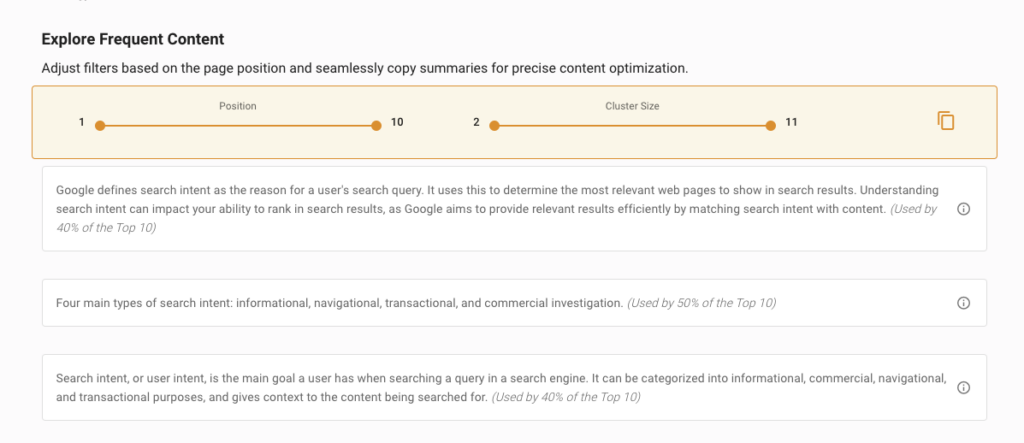
And on top of this, our solution offers ideas for new angles.
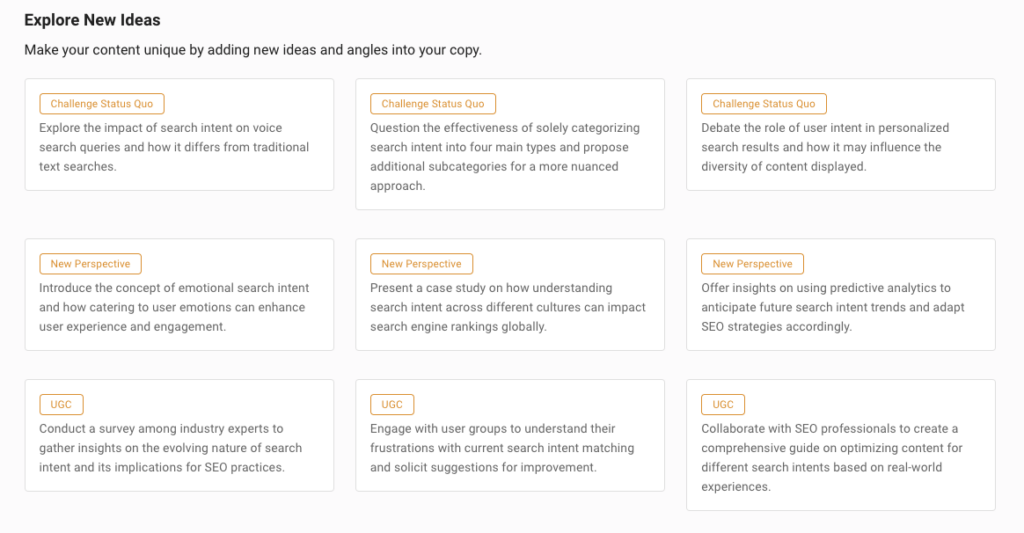
With thruuu, you have the best SEO tool to decipher Google Search, analyze your competitor, and understand how to create helpful content.
Empower Your Content Team
Our end-to-end content optimization solution empowers your team to crack the Google algorithm, craft exceptional content, and achieve remarkable organic search results.
